Do Electric Chainsaws Need Oil? Everything You Need to Know
- January 29, 2024
- 1 comment
When it comes to maintaining your electric chainsaw, one of the most common questions that arise is: Do electric chainsaws need oil? The answer is a resounding yes. Despite the electric motor not requiring gas or fuel additives, the chain of an electric chainsaw requires consistent lubrication with ‘bar and chain’ oil to function smoothly and efficiently.
The Importance of Oiling an Electric Chainsaw
An electric chainsaw, much like any other mechanical tool, relies on proper lubrication to operate effectively. The chain, being in constant motion, faces friction which can lead to wear and tear if not properly lubricated. This is where bar and chain oil comes into play, ensuring that the friction is minimized and your chainsaw operates at its best.
How to Properly Oil an Electric Chainsaw
Oiling an electric chainsaw is a straightforward process:
Step 1: Locate the Oil Reservoir
Electric chainsaws feature a designated oil reservoir, typically marked by a cap located either on the top or side of the machine.

Step 2: Adding Oil
Steadily hold the chainsaw and carefully pour the oil into the reservoir, using a funnel if necessary. Prepare an absorbent surface like cardboard beneath the chainsaw to catch any spills, as bar and chain oil can stain surfaces.
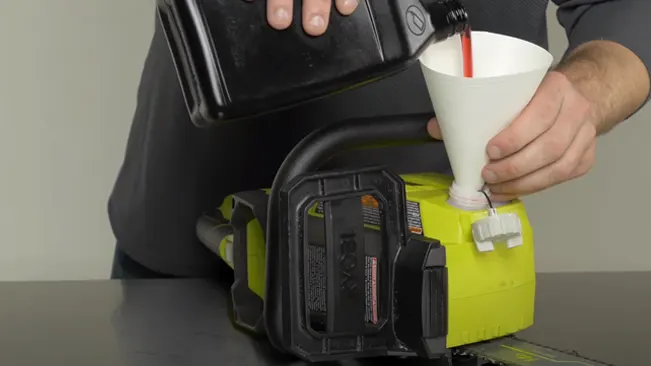
Step 3: Oil Type
Electric chainsaws utilize the same type of bar and chain oil as their gas counterparts. High-quality oils are recommended to ensure low friction and proper lubrication.

Step 4: Refilling Frequency
Prior to each use, check and refill the oil reservoir. For battery-operated chainsaws, synchronize oil checks with battery changes. Corded chainsaws, not limited by battery life, should have their oil levels checked every 20 minutes of use, adjusting frequency based on the intensity of use.
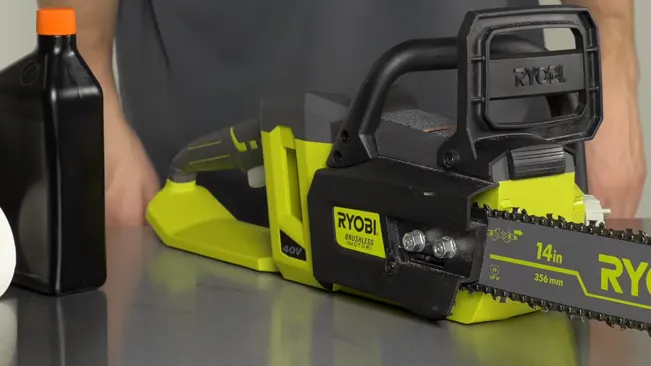
Choosing the Right Oil
Electric chainsaws use the same type of bar and chain oil as their gas counterparts. High-quality oils, such as those offered by Husqvarna, are recommended to ensure low friction and proper lubrication of the moving parts.
Manual Lubrication: A Temporary Solution

While manual lubrication with spray lubricants like Ballistol is possible, it’s not a long-term solution. Manual lubrication wears off quickly and requires frequent application. It’s generally not recommended if your chainsaw has an automatic lubricating system.
Safety and Environmental Considerations for Bar and Chain Oil
When using bar and chain oil in electric chainsaws, it’s crucial to consider both safety and environmental factors. This oil plays a vital role in the maintenance and performance of your chainsaw, but it also comes with responsibilities regarding handling and disposal.
Safety Considerations
- Bar and chain oil should be handled with care. Although it’s not meant for ingestion, accidental spills or contact can occur. It’s advisable to wear gloves when refilling the oil and to work in a well-ventilated area to avoid inhaling fumes.
- Store the oil in a cool, dry place away from direct sunlight and extreme temperatures. Ensure the cap is tightly sealed to prevent leaks, and keep it out of reach of children and pets.
- A significant safety feature of bar and chain oil is its high flash point. This means the oil can withstand high temperatures before igniting, reducing the risk of fire hazards during chainsaw operation. However, it’s still important to avoid exposing the oil or the chainsaw to open flames or extremely high temperatures.
Environmental Considerations
- Be mindful of spills and leaks when refilling your chainsaw’s oil reservoir. Spilled oil can contaminate the soil and water sources, harming wildlife and the ecosystem. Use a funnel when pouring the oil and place a catch tray or absorbent material like cardboard underneath to catch any drips.
- Never dispose of used bar and chain oil in household trash, down drains, or on the ground. Used oil can contain harmful contaminants. Instead, take it to a designated oil recycling center or a hazardous waste disposal facility. Many auto shops and local waste management services offer oil recycling services.
- If you’re concerned about the environmental impact, consider using biodegradable bar and chain oils. These oils are designed to break down more quickly in the environment, reducing the potential for pollution. However, ensure that the biodegradable oil you choose is still suitable for your chainsaw and provides adequate lubrication.
The Risks of Skipping the Oil on Your Chainsaw
Think of oiling your chainsaw as feeding it; without enough ‘food,’ it starts to get cranky, and things go downhill fast. Here’s what happens when your chainsaw is running on empty:
1. Chain Trouble

Imagine your chain is like a sprinter on a track. Without oil, it’s like running in sand; it gets tired, slows down, and might even stop mid-race. The chain gets all worn out, might get stuck, or in the worst case, snap! That’s not just a pause in your work; it’s a trip to the store for a new chain.
2. Guide Bar Blues
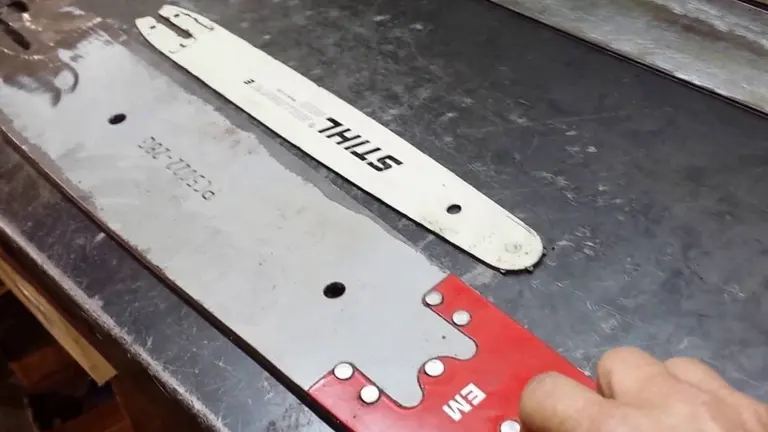
The guide bar is like the chain’s racetrack. No oil? It’s like the track’s on fire! The heat from all that friction can twist and warp the bar. Once it’s out of shape, it’s game over for the guide bar, and you’re off to the store again.
3. Inside Issues
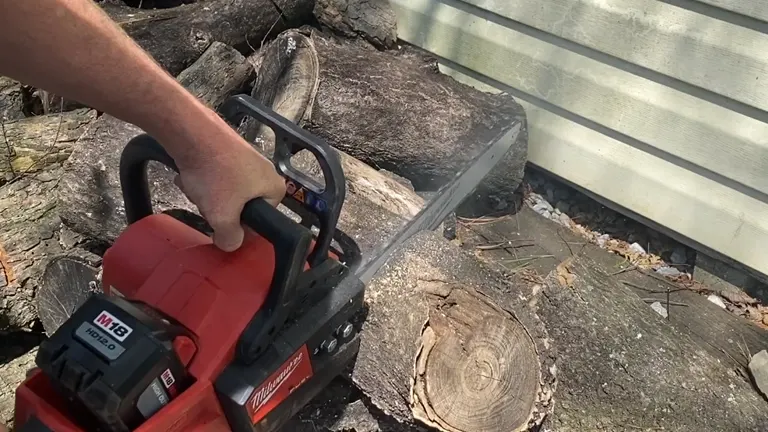
Inside the chainsaw, it’s like a busy factory. Without oil, it’s chaos! Parts grind against each other, heat builds up, and your chainsaw’s inner workings are under siege. It’s like making the engine run a marathon in a desert – it might just give up.
So, remember, oil isn’t just a suggestion; it’s a must! Keep your chainsaw happy, and it’ll keep cutting smoothly for you. No oil means trouble, and who needs that? Keep things slick, and your chainsaw will stick around for the long haul!
Lubrication Oil Characteristics
Chainsaw lubrication oil is specially formulated to be thicker and stickier than standard motor oil, ensuring it stays on the chain during operation. It’s also temperature-sensitive, requiring adjustments based on seasonal changes to maintain its protective qualities.
Buying the Right Oil
When selecting oil for your electric chainsaw, consider the following:
- Choose an oil that maintains its performance across a range of temperatures.
- Opt for biodegradable oils if you’re concerned about environmental effects, especially when pruning or leveling.
- Avoid cheaper oils that can compromise the performance and lifespan of your chainsaw.
If you are looking for the best chainsaw bar and chain oil, check it out here! Best Chainsaw Bar and Chain Oil
Can You Use Vegetable Oil for Electric Chainsaw?

While vegetable oils like canola or sunflower oil can be used as a temporary substitute for bar & chain oil, they are not recommended for long-term use. They lack the stickiness and anti-wear additives of specialized chainsaw oils and can lead to issues if the chainsaw is left unused for extended periods.
The Risks of Running Without Oil
Operating your electric chainsaw without oil can lead to poor cutting performance, serious damage to the chainsaw’s components, and even cause the chainsaw to smoke due to overheating. It’s crucial to ensure that your chainsaw is adequately lubricated at all times to maintain its performance and longevity.
In conclusion, while electric chainsaws don’t require the same type of maintenance as gas-powered ones, proper lubrication of the chain is essential. Regularly checking and refilling the bar and chain oil reservoir will ensure your electric chainsaw continues to operate smoothly and efficiently, prolonging its lifespan and ensuring your safety during use.
Related Articles:
- Can You Use Motor Oil for Chainsaw Bar Oil: What You Need to Know
- Best Chainsaw Bar and Chain Oil
- Why Does My Chainsaw Cut Crooked? Understanding and Fixing the Issue
- How To Start A Stihl Chainsaw Step By Step: A Complete Guide
- Best Electric Chainsaw for the Money 2024
FAQs
- Why do electric chainsaws need oil?
Just like any superstar needs a good support team, your electric chainsaw needs oil to keep its performance top-notch. The oil reduces friction, keeps the chain moving smoothly, and prevents wear and tear on the chain and guide bar. - What happens if I don’t oil my electric chainsaw?
Skipping the oil is like making your chainsaw run a marathon with no water – it’s a disaster waiting to happen! The chain might wear out or break, the guide bar could get damaged, and the internal parts could overheat and get damaged. - Can I use any oil for my electric chainsaw?
Not all oils are VIPs in the world of chainsaws! It’s best to use bar and chain oil specifically designed for chainsaws. It’s stickier and thicker, so it stays on the chain and doesn’t fly off like thinner oils might. - How often should I oil my electric chainsaw?
Treat it like a thirsty plant – before every use, give it a drink of oil. If you’re using it a lot, check the oil level every 20 minutes or so. It’s better to check too often than to run dry! - Can I use vegetable oil as a substitute for bar and chain oil?
In a pinch, vegetable oil can step in, but it’s not a long-term solution. It’s like using a band-aid when you really need stitches – it’ll do the job for a bit, but it’s not the best fix. Vegetable oil doesn’t have the same stickiness and might not protect your chainsaw as well as bar and chain oil. - What should I do if I accidentally spill oil while refilling?
No panic needed! Just clean it up quickly. If you spill it on the ground, use something absorbent like cat litter or sand to soak it up. Remember, spilled oil can be harmful to the environment, so it’s best to avoid spills and clean them up promptly when they happen. - Is it safe to use my electric chainsaw if it’s smoking due to lack of oil?
Smoke is a chainsaw’s way of saying, “Help!” If you see smoke, it’s time for a break. Turn off the chainsaw, let it cool down, and check the oil. Running a smoking chainsaw can lead to serious damage, so it’s best to sort out the issue before continuing. - How do I know if my chainsaw’s guide bar is damaged?
A damaged guide bar is like a wobbly bike wheel – it just doesn’t work right. Look for signs like uneven wear, bends, or cracks. If your chainsaw isn’t cutting straight or it’s vibrating more than usual, it might be time for a guide bar check-up.
Join the discussion below by sharing your experiences, tips, or reviews. Your contributions help others make informed decisions and navigate their chainsaw choices with confidence. Let’s build a community of shared knowledge for all wood-cutting enthusiasts!

David Murray
Forestry AuthorI'm David Murry, a forestry equipment specialist with a focus on chainsaw operation. With over 13 years of experience, I've honed my skills in operating and maintaining a wide range of machinery, from chainsaws to log splitters. My passion for the outdoors and commitment to sustainable forestry drive my work, which emphasizes safety, efficiency, and staying updated with industry advancements. Additionally, I'm dedicated to sharing my expertise and promoting environmental awareness within the forestry community.


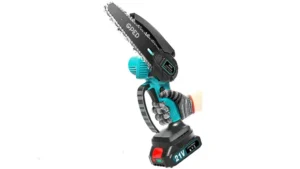
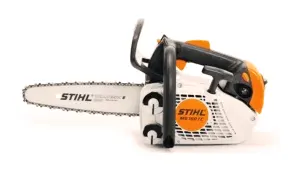
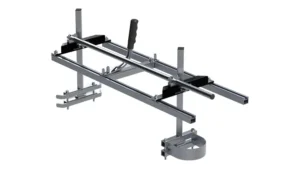
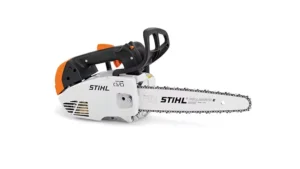
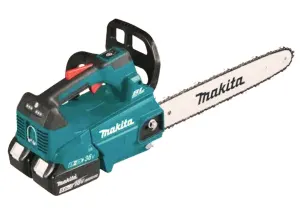


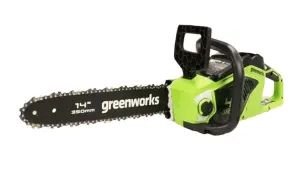
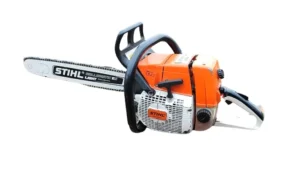


I assume the 16" Ryobi electric I was given is quite old. It has a soft button on the oil filler cap, so I assume it's not automatic. The question is, do I oil it like a gas saw, hold the button down for 3 seconds every 30 seconds or so?
Ian Cameron
May 6, 2024 9:48 pm